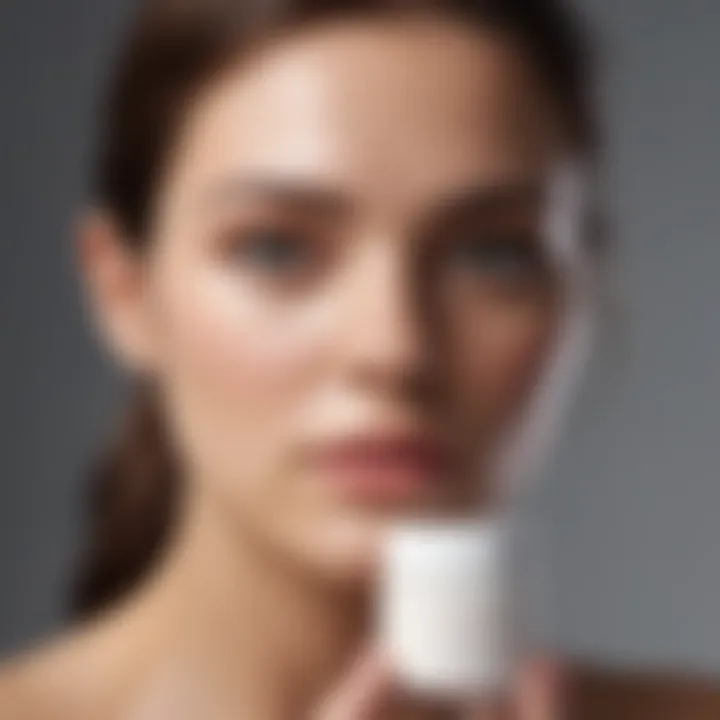The Most Gentle Sunscreen: A Comprehensive Exploration


Intro
Protecting the skin from harmful UV rays is crucial for maintaining overall skin health. Among the various categories of sunscreens, gentle sunscreens have gained significant attention, particularly for individuals with sensitive skin. This section serves as an introduction to the importance of gentle sunscreens and sets the stage for a detailed examination of their characteristics.
Gentle sunscreens are formulated with specific ingredients that cater to delicate skin, reducing the risk of irritation. They play a vital role in contemporary skincare routines, especially for those dealing with conditions like eczema or rosacea. This article will explore key aspects of gentle sunscreens, including their formulation, the types available, and how these align with different skin types and personal needs.
Understanding the nuances of gentle sunscreens not only aids in better skin protection but also enhances one’s skincare experience. As we delve deeper into this comprehensive guide, valuable insights on benefits, market options, and ingredient analysis will be provided, ensuring readers are well-informed about their choices in skin protection.
Understanding Sunscreen and Its Importance
Sunscreen is a crucial component in skincare routines, especially in today’s society where skin protection from harmful ultraviolet (UV) rays is paramount. Understanding the significance of sunscreen provides a foundation for anyone interested in maintaining healthy skin. The rise in skin conditions, including premature aging and skin cancer, further elucidates why incorporating sunscreen into everyday life is essential. Not only minimizes these risks, but it also supports overall skin health by preventing damage that can lead to discoloration, texture changes, and more severe skin issues.
The Role of Sunscreen in Skincare
The primary function of sunscreen is to act as a barrier against the sun’s harmful rays. Ultraviolet B (UVB) rays are known for causing sunburn, whereas Ultraviolet A (UVA) rays penetrate the skin deeper and are associated with longer-term skin damage. By utilizing a broad-spectrum sunscreen, individuals protect themselves from both types of UV rays. The inclusion of sunscreen in one’s daily skincare routine should not be underestimated. It plays an integral role in preventing skin cancer, lowering the incidence of pre-existing skin conditions, and maintaining healthy and youthful skin. Moreover, the daily application of sunscreen helps to even skin tone and texture by preventing the formation of sun spots and hyperpigmentation.
This essential skincare product becomes even more vital for those with sensitive skin. Many prescriptions and over-the-counter products can cause irritation, making the selection of the right sunscreen crucial in these cases. Gentle formulations cater specifically to this demographic, ensuring that the skin is protected without exacerbating any existing issues.
Types of Sunscreens: Chemical vs Physical
When discussing sunscreens, it’s imperative to distinguish between chemical and physical types, as they function differently in their approach to UV protection.
- Chemical Sunscreens: These formulas absorb UV radiation through their chemical filters before it penetrates the skin. Ingredients such as avobenzone, octisalate, and octocrylene are common here. They tend to have a lighter texture and often blend seamlessly into the skin. However, they can cause irritation for those with sensitive skin and may require a little time to activate after application.
- Physical Sunscreens: Known also as mineral sunscreens, these contain active minerals like zinc oxide or titanium dioxide. They work by sitting on the skin’s surface and reflecting UV rays away. Physical sunscreens provide instant protection, making them a more favorable option for those with sensitive skin or conditions like rosacea or acne. They tend to be less irritating overall and more suitable for a wider audience.
Both types have their advantages and disadvantages. Understanding how they work helps individuals make informed choices when selecting a sunscreen suited to their skin type and needs. Considering the potential for skin irritation and the necessity for optimal sun protection is key in determining the best course of action in sunscreen choice.
Defining Gentle Sunscreens
In the search for effective skin protection, gentle sunscreens have emerged as a vital choice for many individuals. Understanding what constitutes a gentle sunscreen can help consumers make informed decisions. This section explores this definition, examining the factors that influence gentleness and their importance in skincare.
What Makes a Sunscreen Gentle?
Gentle sunscreens prioritize skin health and comfort, specially designed for people with sensitive skin or conditions such as rosacea or eczema. The gentleness of a sunscreen typically hinges on two main aspects: the formulation and the presence of irritating ingredients.
- Ingredients: Gentle sunscreens are often free of harsh chemicals, fragrances, and preservatives that can provoke reactions. Instead, they often incorporate safe and soothing components that nourish the skin, minimizing the risk of irritation.
- Application: The texture and feel of the sunscreen when applied also contribute. Gentle formulations are lightweight and absorb easily without leaving a sticky or greasy residue, enhancing user experience.
The combination of these elements ensures that a sunscreen does not only protect from harmful UV rays but also promotes skin integrity and comfort during application.
Common Ingredients in Gentle Formulations
The ingredient list in gentle sunscreens is critical in defining their gentleness. Here are some common ingredients found in these formulations:
- Zinc Oxide: A physical blocker known for its soothing properties. It reflects UV rays and is often well tolerated, even by sensitive skin.
- Titanium Dioxide: Another mineral-based ingredient, also a physical blocker. It is recognized for its mildness and efficacy in protecting skin from sun exposure.
- Aloe Vera: Renowned for its soothing qualities, it helps to calm and hydrate the skin, making it ideal in sunscreen formulations.
- Glycerin: A humectant that aids in maintaining moisture, promoting skin hydration.
- Ceramides: These lipids help restore the skin barrier and retain moisture, contributing to overall skin health.
In contrast, gentle sunscreens typically avoid ingredients such as parabens, sulfates, and artificial fragrances which could irritate the skin. This focus on beneficial and benign components ensures that users can find a suitable option even if they have very reactive skin conditions.
"Choosing the right sunscreen is essential to ensuring both safety from UV exposure and comfort for sensitive skin types."
By understanding the definition and notable ingredients, consumers can seek out gentle sunscreens that provide effective protection without compromising skin health.
Key Benefits of Gentle Sunscreens
The relevance of gentle sunscreens is constantly growing, especially as awareness about skincare increases. Many people seek protection from sun exposure without the risk of irritation. Gentle sunscreens offer a plethora of benefits that make them particularly appealing to individuals with delicate skin.


Minimizing Skin Irritation
Gentle sunscreens are designed to minimize skin irritation, a common issue caused by harsh chemical filters found in many traditional products. Skin irritation can manifest as redness, dryness, and even breakouts. By choosing a sunscreen specifically labeled as gentle, individuals are more likely to find formulas that avoid aggressive ingredients.
These products often use physical blockers such as zinc oxide or titanium dioxide. Unlike chemical sunscreens, these mineral-based alternatives sit on the skin’s surface, providing a protective barrier without being absorbed into the skin. This mechanism reduces the potential for allergic reactions or sensitivities, especially for individuals prone to conditions like rosacea or eczema.
Benefitting Sensitive Skin Types
Sensitive skin types are often easily affected by environmental stressors. This includes not only sunlight but also pollutants. Gentle sunscreens can provide the necessary protection while ensuring the formulation is soothing rather than disruptive. The inclusion of calming ingredients such as aloe vera or chamomile can enhance the protective function of these products.
Many individuals with sensitive skin notice a marked difference when they switch to gentler formulations. They often report fewer breakouts and less redness. Gentle sunscreens can thus serve as both a barrier against the sun and a part of the skincare regime that promotes an overall healthier skin condition.
Suitable for Daily Use
Another significant benefit of gentle sunscreens is their suitability for daily use. Unlike traditional sunscreens that may feel heavy or greasy, many gentle formulations are lighter. They absorb well into the skin, providing a comfortable wear throughout the day. This encourages consistent application, a crucial factor in effective sun protection.
Gentle sunscreens can seamlessly integrate into any daily skincare routine. Whether used under makeup or alone, their lightweight texture appeals to a broad audience. By ensuring daily use, individuals significantly improve their skin’s protection from harmful UV rays, which can contribute to premature aging and skin damage over time.
"The best sunscreen is the one you will actually use every day. Gentle formulations encourage consistent application, simplifying the sun protection routine."
Thus, the benefits of gentle sunscreens extend beyond mere sun protection. They offer solutions that cater to delicate skin, promoting a well-balanced skincare regimen while alleviating concerns about irritation.
Considerations for Choosing Gentle Sunscreens
Choosing the right sunscreen is critical, especially for individuals with sensitive skin. The term "gentle sunscreen" implies a formulation that prioritizes skin comfort while providing adequate protection. Understanding what to look for becomes essential for ensuring effective sun protection without adverse reactions.
Identifying Your Skin Type
Determining your skin type is a necessary first step. Skin can be categorized as oily, dry, combination, or sensitive. Each type has different needs regarding sun protection and ingredient compatibility.
- Oily Skin: If you have oily skin, look for gel-based or matte finishes. These products often contain non-comedogenic ingredients that do not clog pores.
- Dry Skin: For dry skin, opt for creams or lotions that are hydrating. Ingredients like glycerin or hyaluronic acid can provide moisture while protecting the skin.
- Combination Skin: Pick a balanced product that can work well across different areas of your face and body.
- Sensitive Skin: Individuals with sensitive skin must be particularly cautious. A sunscreen labeled as hypoallergenic or fragrance-free can minimize the risk of irritation.
Understanding SPF and Broad-Spectrum Protection
Next, comprehend the significance of SPF and broad-spectrum protection. SPF stands for Sun Protection Factor and indicates how well a product protects against UVB rays, which are primarily responsible for sunburn.
- SPF Values: An SPF rating of 30 is often recommended for daily use, blocking about 97% of UVB rays. Higher SPF values offer slightly greater protection; however, it is important to remember that no sunscreen can provide 100% protection.
- Broad-Spectrum Protection: In addition to UVB protection, a sunscreen should offer broad-spectrum protection. This means effective defense against UVA rays, which contribute to skin aging and skin cancers. Always look for products that explicitly state they are broad-spectrum.
Ingredient Awareness: What to Avoid
Finally, awareness of sunscreen ingredients is crucial. Certain components can lead to irritation or breakouts, especially in sensitive skin. Here are some common ingredients to avoid:
- Alcohol: Denatured alcohol can dry out the skin and cause irritation.
- Fragrances: Artificial fragrances often lead to allergic reactions; choose unscented formulations instead.
- Oxybenzone: This chemical sunscreen agent has raised concerns regarding skin absorption and interaction with hormones.
- Parabens and Sulfates: These preservatives can lead to sensitivity in some individuals.
By focusing on the aspects mentioned above, individuals can make informed decisions when selecting a sunscreen that meets their unique skin needs while also prioritizing skin health.
Popular Gentle Sunscreen Products
Sunscreens that are regarded as gentle play a critical role in daily skincare routines, particularly for individuals with sensitive skin. As we navigate the world of skincare, recognizing the most suitable gentle products can profoundly impact overall skin health and comfort. This section focuses on the importance of choosing gentle sunscreens, highlighting effectiveness and tolerability.
Top Recommendations for Sensitive Skin
Selecting the right sunscreen is paramount for those with sensitive skin types. Sun exposure can provoke reactions, unearthing redness and irritation. Thus, gentle options become the optimal choice. Here are some notable sunscreen products recommended for sensitive skin:


- La Roche-Posay Anthelios Mineral SPF 50: This formula is lightweight and provides broad-spectrum protection without many irritating ingredients, often praised for its soothing properties.
- Aveeno Positively Mineral Sensitive Skin Sunscreen SPF 50: Known for its nourishing oat extract, this product offers protection while being suitable for all skin types, especially sensitive ones.
- Blue Lizard Australian Sunscreen SPF 30+: This reef-safe product is designed for sensitive skin without harsh chemicals, making it a safe option for extended outdoor exposure.
Each of these products is formulated prioritizing skin health, employing ingredients known for their gentleness.
Conventional vs. Organic Brands
The skincare market presents an array of choices between conventional and organic sunscreen brands, with each offering different benefits. Understanding these differences can guide informed decisions. \nConventional Brands often focus on high efficacy and accessibility. They provide a variety of formulations, allowing easy access to effective sun protection.
- Advantages include established safety and regulatory standards.
- They tend to deliver results quickly, offering more robust findings in efficacy testing.
On the other hand, Organic Brands generally stress using natural ingredients and eschew synthetic chemicals. This can be appealing for users seeking to minimize their exposure to potential irritants.
- Often, they adopt eco-friendly practices.
- They tend to cater to niche consumers who prefer minimalism in their skincare routines.
Both types of brands can produce gentle options, but the differences in formulas underline the importance of scrutinizing individual ingredients. Consumers should read labels and choose based on personal skin responses.
While both categories have their benefits, making an informed choice requires considering individual skin needs and the formulation of each product.
Understanding Efficacy and Testing
Understanding the efficacy of sunscreens, especially gentle formulations, is essential for informed consumer choices. Efficacy refers to how well a sunscreen can protect skin from harmful ultraviolet (UV) rays. Testing protocols are crucial because they ensure that products meet the necessary standards for safety and effectiveness. This section explores how sunscreens are tested, the metrics used to assess their real-world performance, and the implications for consumers.
How Sunscreens Are Tested
Sunscreens undergo rigorous testing to verify their claims regarding SPF, water resistance, and broad-spectrum protection. The most common method for testing SPF involves applying a certain amount of sunscreen to participants' skin and exposing them to UV radiation. The time it takes for participants to show signs of sunburn is measured. This defines the SPF value of the product.
Moreover, testing for water resistance is also critical. A variety of protocols exist, typically categorized into water-resistant and very water-resistant. Testing assesses how well a sunscreen maintains its protection level after being submerged in water.
Various testing standards exist globally. For example, the FDA in the United States stipulates specific measures for testing products. By adhering to these guidelines, manufacturers can earn their products certified recognitions.
Real-World Performance Metrics
Evaluating sunscreen performance in real-world conditions is vital and goes beyond laboratory testing. Consumers need to know how products perform under typical usage situations such as sweating, swimming, and prolonged sun exposure.
Factors influencing real-world efficacy include:
- Environmental Conditions: Heat, humidity, and wind can affect sunscreen durability.
- Application Thickness: The amount applied impacts its protective capabilities, with many users applying significantly less than recommended.
- Duration: Sunscreens can degrade with time, particularly but not exclusively during activities like swimming or excessive sweating.
A review of consumer experiences, including user feedback and product reviews, can provide further insight into how a sunscreen performs over time. Studies and surveys conducted on larger scales can highlight any discrepancies between lab-tested performance and daily experiences.
"Understanding efficacy and performance helps consumers make informed choices that safeguard their skin without irritation—essential for everyone especially those with sensitive skin."
Selecting gentler sunscreens should not compromise efficacy. Therefore, comprehending how sunscreens are tested and recorded enables consumers to choose products that suit their lifestyles and skin needs effectively.
Common Misconceptions About Sunscreens
In exploring the realm of gentle sunscreens, it is crucial to address the common misconceptions that surround them. Understanding these misconceptions can lead to better decisions when selecting a sunscreen. Many consumers may have misguided beliefs about how sunscreens function or the ingredients they contain. This section will clarify essential points about sunscreen efficacy and composition, helping readers navigate the complexities of sun protection.
The Myth of SPF Values
One prevalent myth is the belief that a higher SPF automatically equates to greater protection. SPF, or Sun Protection Factor, measures the sunscreen's ability to prevent UV rays from causing sunburn. However, the difference in protection between SPF 30 and SPF 50 is not as significant as many think. For example, SPF 30 blocks about 97% of UVB rays, while SPF 50 blocks around 98%. This marginal increase in protection leads some to overestimate the importance of high SPF ratings.
Additionally, many individuals also forget that SPF does not measure UVA protection, which is critical as UVA rays can contribute to skin aging and cancer. Therefore, consumers should always look for "broad-spectrum" labels, ensuring protection against both UVA and UVB rays. Contrary to belief, effective protection doesn't solely rely on the SPF number; proper application and reapplication are equally important.


Misunderstanding Chemical Ingredients
Another misconception involves the ingredients in sunscreens, especially chemical ones. Some consumers fear chemical sunscreens, assuming they are harmful. Many think that if a product is labeled as chemical, it must be less safe for their skin. However, this is a misunderstanding.
Chemical sunscreens contain organic compounds designed to absorb UV radiation. Common ingredients include avobenzone and octisalate. These compounds can effectively protect skin without irritating it for most users. The concern arises from the potential for allergic reactions or irritation, which can occur with both chemical and physical formulations. It's essential to choose a product based on individual skin sensitivity, rather than the blanket assumption about chemical sunscreens being harmful.
Indeed, many brands now prioritize safety and efficacy in their formulas. As some people are concerned about environmental impact, they might prefer gentler options that avoid ingredients like oxybenzone, which has gained notoriety for its effect on coral reefs. This highlights the importance of ingredient awareness. Checking the label is vital for finding a sunscreen that suits personal needs, ensuring both skin safety and environmental consideration.
Understanding these common misconceptions not only enhances consumer knowledge but also empowers individuals to make informed decisions about their sun protection, ensuring they receive adequate care without unnecessary worry.
In summary, debunking these myths surrounding SPF values and sunscreen ingredients is crucial for making informed choices. Recognizing the nuances of sunscreen application and formulation will result in better protection and overall healthier skin.
Sunscreen Application Techniques
Sunscreen application techniques play a crucial role in realizing the full benefits of sun protection. Effective application enhances the efficacy of the product, ensuring that it provides the intended protection against UV rays. Proper techniques are especially important for gentle sunscreens, which cater to sensitive skin. The right application minimizes the risk of irritation and maximizes skin safety.
Proper Application for Maximum Efficacy
When applying sunscreen, the method is as significant as the product choice itself. Here are some essential steps to follow for optimal sunscreen application:
- Choose the Right Amount: It’s recommended to use about a quarter of a teaspoon for the face and a full shot glass worth for the body, ensuring all exposed areas are covered.
- Clean and Dry Skin: Always apply sunscreen on clean and dry skin. This allows the product to adhere better, providing a more effective barrier against UV rays.
- Apply Before Sun Exposure: For maximum protection, sunscreen should be applied at least 15 to 30 minutes before going outside. This allows the ingredients to interact properly with the skin.
- Even Coverage: Spread the product evenly over all exposed skin, including areas often overlooked like the ears, neck, and feet. Avoid sparing application.
- Use Gentle Techniques: When dealing with sensitive skin, use gentle, circular motions to apply sunscreen. This reduces the risk of irritation, allowing the product to blend seamlessly into the skin.
By adhering to these steps, one can assure that the gentle sunscreen performs at its best, allowing sensitive skin types to safeguard against harm without discomfort.
Reapplication Guidelines
Reapplication is a vital aspect of sunscreen use that many individuals overlook. Understanding when and how to reapply is essential for maintaining effective sun protection throughout the day. Here are important guidelines:
- Frequency: Sunscreen should be reapplied every two hours, regardless of the SPF rating. This rule holds true even for water-resistant products.
- After Swimming or Sweating: If you are swimming or sweating, it is necessary to reapply sunscreen immediately after exiting the water or once sweat has dried.
- In Specific Conditions: On days with high UV index levels, increased frequency of application may be warranted. This applies especially to individuals with very fair skin or those who sunburn easily.
- Formulation Matters: Consider the formulation for reapplication; spray sunscreens can be convenient for ease of use but ensure even coverage. A cream or lotion may be preferable for precise application.
Remember: Consistent reapplication is critical to prevent sunburn and long-term skin damage, making it an essential aspect of any sunscreen regimen.
In summary, effective sunscreen application and reapplication techniques are integral to maximizing the protective benefits of gentle sunscreens. By following these straightforward methods, users can ensure that their skin remains protected from harmful UV exposure, helping to preserve skin health over time.
Environmental Considerations
Environmental considerations regarding sunscreen are crucial in today’s world. With increasing awareness of ecological impact, it becomes essential to evaluate how certain ingredients in sunscreens influence the environment. The discussion extends beyond personal skincare to encompass a broader responsibility toward our planet’s health.
Impact of Sunscreen on Marine Life
Research indicates that some sunscreen ingredients can be harmful to marine ecosystems. Chemicals such as oxybenzone and octinoxate are prevalent in many formulations. These substances can lead to coral bleaching, which disrupts aquatic life. According to scientific studies, as little as a drop of sunscreen can contaminate an area of ocean water equivalent to approximately six and a half Olympic-sized swimming pools.
Marine life is sensitive to a sunscreen’s chemical composition. The adverse effects include not only the impact on coral reefs but also harm to fish and other organisms. Coral reefs, which provide habitat for approximately 25% of all marine species, are particularly vulnerable. It is therefore vital for consumers to seek out ocean-friendly products that avoid harmful ingredients, ensuring both skin protection and environmental integrity.
Sustainable Sunscreen Practices
Sustainable practices in sunscreen formulation and application can significantly minimize environmental harm. Here are several important aspects to consider when selecting a gentle sunscreen:
- Choose reef-safe formulations: Look for products that do not contain harmful chemicals. Ingredients like zinc oxide or titanium dioxide are generally safer alternatives. This not only protects your skin but reduces ecological damage.
- Packaging matters: Sustainable brands often use recyclable or biodegradable materials for their packaging. Supporting such brands is essential for reducing plastic waste in oceans and on land.
- Support responsible companies: Many brands donate a portion of their profits to marine conservancy efforts. Supporting these companies can help foster positive change in the industry.
- Practice responsible application: Apply sunscreen away from water bodies. This allows the product to absorb into your skin rather than washing off into sensitive marine environments.
By combining personal skincare with conscious choices, consumers can play a role in fostering healthier ocean ecosystems. Implementing sustainable practices ensures we protect our skin while respecting our planet.
The End: The Future of Gentle Sunscreens
As skincare trends continue to evolve, the significance of gentle sunscreens remains paramount. The increasing awareness surrounding skin health and the potential hazards of certain ingredients has led to a growing demand for products that effectively protect against UV damage while minimizing irritation. This article has explored the nuances of gentle sunscreens and their vital role in modern skincare. It has highlighted the intricacies of formulation, ingredient selection, and consumer preferences, underpinning the relevance of gentle sunscreens as a necessity rather than a luxury.
Trends in Formulation and Consumer Awareness
The landscape of sunscreen formulation is undergoing a transformation. Brands are now more attuned to the needs of consumers, particularly those with sensitive skin. This shift is resulting in innovative products that prioritize skin compatibility. Key trends include:
- Natural Ingredients: There is a noticeable movement towards formulations that utilize natural and organic components. These ingredients often provide effective sun protection without the harshness associated with many chemical sunscreens.
- Minimalist Formulations: Many consumers prefer products with fewer ingredients. This trend reflects a desire for transparency and simplicity in skincare. Brands are responding by creating gentle formulas that avoid unnecessary additives.
- Enhanced Testing Practices: As the focus on safety intensifies, companies are investing in rigorous testing for their products. This approach not only ensures that sunscreens perform well but also that they do not pose a risk of irritation to the user.
- Increased Awareness of Environmental Impact: Consumers are increasingly aware of the ecological repercussions of sunscreen ingredients, particularly concerning marine life. Consequently, many brands are now producing reef-safe sunscreens, thus protecting the environment alongside skin health.



